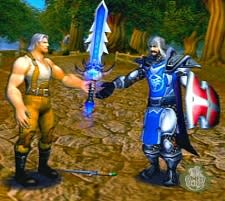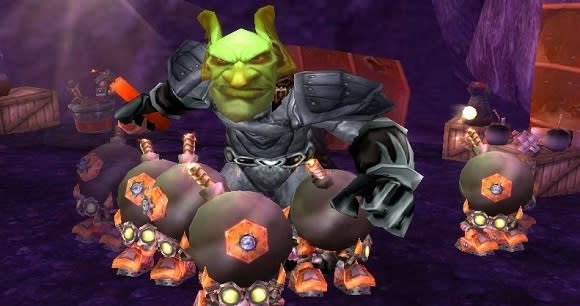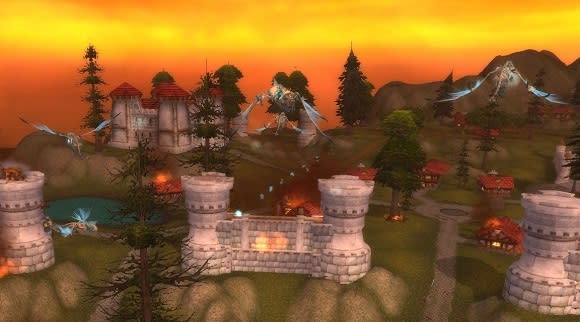WoW Archivist: Beta surprises from World of Warcraft's history
WoW Archivist is a biweekly column by WoW Insider's Scott Andrews, who explores the secrets of World of Warcraft's past. What did the game look like years ago? Who is etched into WoW's history? What secrets does the game still hold? It first appeared on our sister site on July 2nd and is included here by permission.
Last week, we launched into the newest beta in WoW's history -- its sixth! -- for Warlords of Draenor. It's an exciting time for the game. Every beta has its surprises, good and bad. New things that were never announced. Prior announcements that changed unexpectedly. We've already had a number of surprises in the Warlords beta: the faction hub shift to Ashran, cross-faction auctions, and the removal of guild leveling.
Beta is just ramping up. We are sure to encounter more than one surprise over the next few months as we test the Draenor experience and gear up for the expansion's launch. Let's take a look back at the previous five betas and examine some of the twists that greeted testers -- and often shocked the WoW community. Caveat: I'm excluding storyline surprises.
The original beta
In 2003 and early 2004, players didn't really know what to expect from a World of Warcraft MMO. Blizzard, after all, had never made one before. Most of the original beta served up surprise after surprise. Yet a few stand out.
Tired heroes. Patch 0.6 introduced the first incarnation of the rest system. Today it is simply a bonus for players who don't have time to log in every day. The original version was more like the Chinese government's "anti-obsession measures": It punished you for playing too long. The system looked like this:
Normal gave 100% XP
Well rested gave 200% of the XP from a mob kill
Rested gave between 100% and 200% XP
Fatigued gave 50% XP
Exhausted gave 25% XP
Your hero needed a good night's rest -- a full eight hours at an inn -- to go from exhausted to normal. Players had an almost universal dislike for this system, and they expressed it in no uncertain terms. Blizzard removed the punishment levels of rest in patch 0.7. At that point, it was a three-tiered system, with an intermediate 150% XP stage. The next beta patch changed it to the system we all know and love today.
Unbuckled. In beta, shields came in two flavors: large shields and smaller bucklers. Rogues and Hunters could wield the latter in the off hand instead of a second weapon. These two classes seemed poised to have some facility with off-tanking. Abilities like Evasion served as tanking cooldowns and Vanish/Feign Death as aggro dumps for tank switches. Patch 0.8 removed Rogues' and Hunters' ability to equip bucklers. With it went the distinction between the shield types as well as their off-tanking dreams. Blizzard gave shields to the Shaman class in the same patch, presumably so shields could be equipped by more than just Warriors on the Horde side.
The culling of auctions. Beta patch 0.9 removed auction houses from all cities except Orgrimmar, Ironforge, and Booty Bay. Blizzard originally gave each city its own, unlinked auction house. Today, even having three houses per realm is considered fractured, and Blizzard is linking them. Players would have figured out rather quickly which AH gave them the best chance to buy and sell items and flocked to that one. It made sense to do away with all but one per faction. Blizzard later figured out how to link the houses, so it put the old auction houses back in business in patch 1.9.
Talking trash. Up until patch 0.11, Forsaken spoke Common. From a lore perspective, of course they could. They were human, after all. Just a bit less... technically alive. Yes, that meant Forsaken players could communicate with the other faction and vice versa. In the patch, Blizzard changed their languages to Gutterspeak and Orcish. I don't think anyone at this point would argue that WoW should have gone live with cross-faction Forsaken chat, but at the time the decision was controversial. Lore was part of the problem, since Gutterspeak wasn't exactly canon. But players also enjoyed a limited way of sending messages to the other side. I imagine Blizzard's ultimate decision on this had a lot to do with the content of those messages...

The beta crusade
Blizzard had a good grip on this expansion before the beta went live. Most of The Burning Crusade's bombshell announcements landed well before the beta. Raid size changes, heroic dungeons, the brand-new PvP system, and arenas were all known before the beta launched. But that doesn't mean the beta held no surprises for us.
No Outland, no leveling. When Blizzard announced that The Burning Crusade would raise the level cap to 70, players wondered whether the extra levels would be an expansion-only feature or it would be possible to level past 60 within the base game. Believe it or not, we didn't know the answer to that question until just before the closed beta launched. The answer, of course, was that we'd have to buy the expansion to keep leveling.
No N in NDA. One unexpected gift in the TBC beta was the lack of a non-disclosure agreement. This decision made players ecstatic. We were incredibly excited to see what WoW's first expansion had in store for us. In the wake of all the uproar over pre-beta announcements, Blizzard was also anxious for players to dive into Outland and see how epic it was shaping up to be. An NDA for the beta didn't serve much purpose in this case, and it was a win-win for both Blizzard and the community. Blizzard has continued that tradition for most betas ever since.
Gun show in Quel'thalas. When the first Blood Elf models came to light, the men were decidedly less beefy than other male races. Blood elf men spent the first two weeks of closed beta pumping iron. They came back in beta build 5866 with some additional mass. The new models were met with criticism and disappointment, since the Horde already had plenty of options if you preferred a musclebound look. On the plus side, Lor'themar could finally say yes when bros asked him, "Do you even lift?" Some even interpreted the change as Blizzard caving to homophobic comments about the male elves.

Salzman in Accounting. South Park's Emmy-nominated parody of WoW was an instant classic. The plot of the episode hinged around a mythical item called the Sword of a Thousand Truths, foretold by Salzman in Accounting. Players were clamoring for the sword to appear in the game. It finally did during the Burning Crusade beta, with the description "Finely crafted to Salzman's specification." Before the sword went live, however, it was renamed as the far less exciting Gladiator's Slicer. Players were bummed about the change, so Blizzard later added a sword called Slayer of the Lifeless. The name is a reference to the show's ultimate question, "How do you kill that which has no life?" The tooltip on the sword reads "Foretold by Salzman." Relevant trivia: The in-game scenes for the South Park episode were created using the Burning Crusade alpha realm.
Beta of the Lich King
Downfall of downranking. Early in the Wrath beta, a small build was pushed to the server that forever changed the way we play our classes. Downranking was a common practice in classic WoW and TBC. Our spellbooks didn't have just one version of a spell. Every time we learned a new rank of the spell, which occurred about every 10 levels or so, that rank was added to our spellbook alongside all the previous ranks. Using lower ranks was an important way for healers to conserve mana. With enough gear, you could forget the higher ranks entirely and earn across the bound discounts on healing. Some DPS classes also used downranking to trigger procs or set up a higher damage spell. But on August 14, 2008, that all changed. Lower ranks of spells now had higher mana costs than their max-rank versions. A change like this had been hinted at. Blizzard had already nerfed the spell coefficients for the lower ranks. But the killing blow landed on the beta realm with no warning. Zarhym later confirmed that Blizzard wanted to end downranking once and for all.
Phased and confused. That same August, players in the Wrath beta were experiencing the Death Knight starting experience for the first time. Everyone assumed that the changing versions of the Plaguelands were different instances. After all, how else could you transform entire areas of the game like that? The method came to light in an August 28 Eurogamer interview. Even Tom Chilton didn't understand what Blizzard's developers had done. He talked about "using instancing a lot more" in the expansion, including the death knight starting zone. "The world changes dynamically as you move through the story," he said. But it wasn't instancing, as J. Allen Brack cut in to reveal. Then he dropped a term that would redefine what is possible in WoW storytelling: "phasing technology." Minds were blown. It was a shiny new tool in Blizzard's toolbox, one it would use to great effect in Northrend.
Sick of potions. A beta build in late July introduced a new illness to Azeroth: potion sickness. In classic WoW and TBC, it was standard practice for high-end raiders to "chain chug" -- to use a potion every 2 minutes of every progression fight. That was what the game allowed and the toughest fights were balanced with that in mind. Raiders made alchemists rich. But potion sickness sought to end the madness of chain chugging. It put a debuff on players so they couldn't drink another potion until they had exited combat. In other words, players went from drinking three to five potions per boss to one. It was an even harsher restriction than we have today with our pre-potting.
Many players were excited that they would no longer have to farm for potion mats for hours on end or spend a fortune on them at the auction house. Alchemists were not fans of this change. Raiders were worried that they would constantly run out of mana. The forums erupted with arguments. So the potion sickness debuff disappeared from the beta a week later, with no comment from Blizzard. Players debated whether the change would actually go live in 3.0. In the end it did, but the debuff didn't. It was the debut of the system we have now, with pre-potting allowed but not multiple potion use in combat.

Real dummies. One of the strange side notes of WoW is that the game has had training dummy models around the world ever since launch, but we couldn't actually use them to train until Wrath. Through all of TBC, players used the unkillable but damageable NPC Dr. Boom to practice and experiment with their rotations. It wasn't ideal, since the doctor was level 68. Also, melee had a tough time with this setup since Dr. Boom's degree isn't in philosophy. But the doc was what we had, so DPS players used him. A September beta build added actual attackable training dummies to Dalaran and other cities. Players rejoiced and were soon amazed by their own damage output -- until they realized the dummies were all level 1. Later in the beta, the dummies did some questing and leveled up to 80 to provide more accurate results.
Later this month, I'll look at more Wrath surprises, along with those from the Cataclysm and Mists of Pandaria betas.

WoW Archivist is a column by WoW Insider's Scott Andrews; it runs on Massively by permission. Every other weekend, Scott explores the secrets of World of Warcraft's past. What did the game look like years ago? Who is etched into WoW's history? What secrets does the game still hold?


